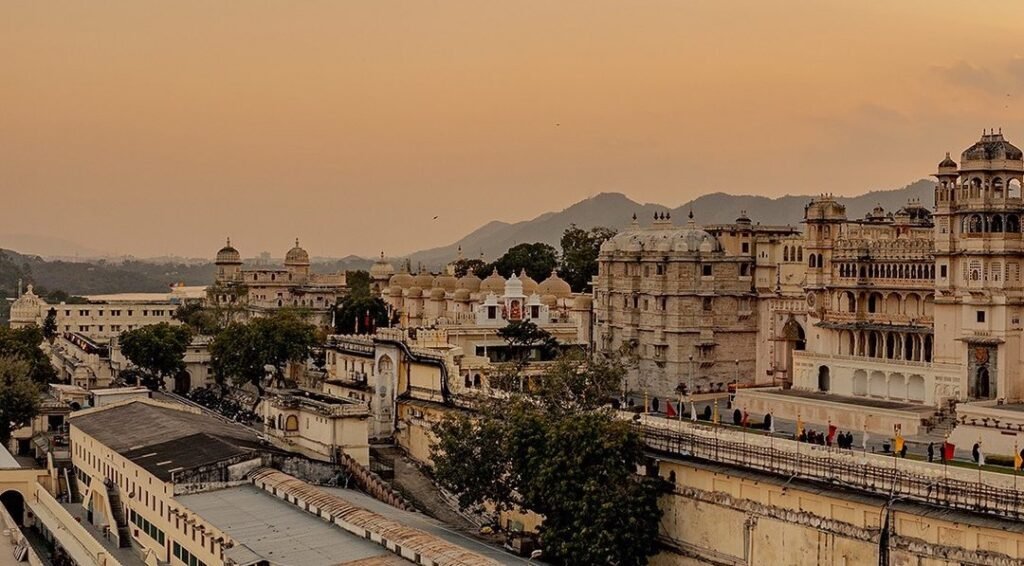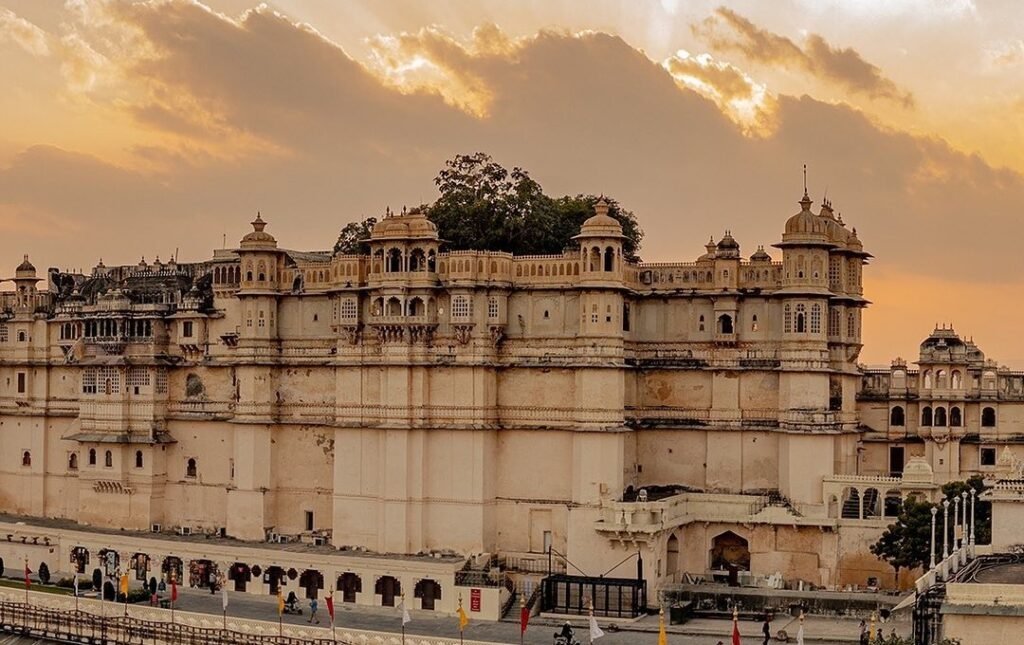The City Palace in Udaipur is one of India’s most iconic and grand palace complexes, situated on the eastern banks of Lake Pichola in Rajasthan. Built over a period of almost 400 years by successive rulers of the Mewar dynasty, it brilliantly showcases the region’s rich history, vibrant culture, and architectural genius. Today, City Palace is not just a living museum to Rajasthan’s regal past but also a thriving tourist destination and cultural symbol of Udaipur.
| Aspect | Details |
|---|---|
| Founded | 1559 AD by Maharana Udai Singh II |
| Construction Period | ~400 years, with contributions by 22 rulers of the Mewar dynasty |
| Location | Eastern bank of Lake Pichola, Udaipur, Rajasthan, India |
| Architectural Styles | Fusion of Mughal, Rajasthani, European and Chinese architecture; extensive use of marble and granite |
| Complex Features | 11 interconnected palaces, courtyards, terraces, gardens, towers, balconies, gates, museum |
| Must-See Attractions | Amar Vilas (garden), Sheesh Mahal (mirror palace), Badi Mahal (garden palace), Mor Chowk (peacock mosaics), Zenana Mahal (women’s quarters), Museum, Crystal Gallery |
| Cultural Role | Heart of Mewar tradition; festivals, exhibits, and royal ceremonies; residence of Arvind Singh Mewar |
| Museum | City Palace Museum, established in 1969, features art, textiles, weaponry, and royal memorabilia |
| Tourism | Rajasthan’s largest palace complex; major attraction; about 1 million annual visitors; key driver for city revenue |
| Film Location | Featured in movies: “Octopussy” (James Bond), Bollywood films |
| How to Reach | By air (Udaipur airport, 24 km), train (Udaipur City railway, 3 km), road (in Old City, local transport available) |
| Visitor Facilities | Wheelchair accessible entrance, parking, restrooms, paid parking lot, ticket counter, audio guides; open daily 9 am–9 pm |
| Tickets | Priced by nationality, age; separate charges for museum, exhibitions, photography; group concessions available |
| Economic Impact | Major GDP contributor for Udaipur and Rajasthan through entrance fees, museum, hospitality, and related commerce |
| Ownership | Owned and partly occupied by Mewar royal family, managed by Maharana of Mewar Charitable Foundation |
| Unique Fact | Built atop a hill for defensive advantage, interconnected passages were designed to confuse attackers |
| Nearby Attractions | Lake Palace, Jag Mandir, Bagore Ki Haveli, Fateh Sagar Lake, Monsoon Palace |
Key Attractions within City Palace
Some of the most unmissable highlights of City Palace include:
- Amar Vilas: Elevated garden with decorative fountains and sweeping surroundings
- Sheesh Mahal: Exquisite mirror work creating kaleidoscopic visual effects
- Badi Mahal (Garden Palace): Set on a high natural rock with lush greenery
- Mor Chowk (Peacock Courtyard): Famous for its intricate mosaics of peacocks
- Zenana Mahal: Detailed exhibition of the lives of royal women
- The Palace Museum: Expansive collection of armory, paintings, art, crystal, vintage cars, and royal paraphernalia
The palace’s many gates (pols), towers, and vistas make every turn a photographic opportunity, blending romance and royalty.
How to Reach City Palace, Udaipur
Location: Old City, Udaipur, Rajasthan 313001, India.
- By Air: Udaipur’s Maharana Pratap Airport is about 24 km from the palace. Regular flights connect to Delhi, Mumbai, Jaipur, and major Indian cities.
- By Train: Udaipur City Railway Station is less than 3 km from the palace. Trains from Delhi, Jaipur, and Ahmedabad are convenient options.
- By Road: The palace is in the historic Old City; auto-rickshaws, taxis, and local buses are readily available.
- Tourist Buses: Most Rajasthan and Udaipur city tours include the City Palace as a major stop.
Tickets, Timings & Visitor Facilities
Operating Hours: 9 am to 9 pm, seven days a week.
- Museum Timings: Entry typically permitted until 4:30–5 pm for the main museum.
- Tickets: Ticket prices vary by nationality and age. Indian adults usually pay a lower price than international tourists. Discounts for children, students, and groups are available. Separate charges may apply for museum entry, photography, and special exhibitions.
Facilities:
- Wheelchair-accessibility (entrance, parking, restrooms)
- Paid parking lot, restrooms, Audio Guide services
- Credit/debit card and digital payment acceptance
History of City Palace
The foundation stone for the City Palace was laid in 1559 by Maharana Udai Singh II, the founder of Udaipur. Maharana Udai Singh II shifted his capital from Chittorgarh to this strategically located site, surrounded by forests, hills, and lakes, following guidance from a hermit and prompted by the threat from the Mughal empire. Construction continued for nearly four centuries, as each subsequent Mewar ruler added his own palaces, courtyards, and distinctive details. This gradual, multi-generational expansion explains the architectural variety and immense scale seen today.
The City Palace witnessed and survived multiple historical events, including conflicts with the Mughal and Maratha empires, making it a symbol of Rajput resilience and valour. The palace remained the royal residence and administrative hub of the Mewar dynasty well into the 20th century, even as the political power of the Maharanas waned.
Architecture and Layout
City Palace, Udaipur, is a masterclass in blended architecture, merging Mughal, Rajasthani, European, and Chinese styles. Constructed primarily from granite and marble, it includes:
- 11 major palaces within a single sprawling complex
- Multiple courtyards, terraces, hanging gardens, balconies, towers, and cupolas
- Highlights such as Amar Vilas (elevated garden with panoramic views), Badi Mahal (Garden Palace atop a 27-meter rock), and the dazzling Sheesh Mahal (Palace of Mirrors)
- Intricate glasswork, mirrorwork, inlay, and wall paintings throughout the complex
Together, these features create a labyrinthine and visually rich palace compound, uniquely adapted to Udaipur’s lakeside landscape and climate.

Culture and Significance
City Palace stands at the heart of Udaipur’s cultural identity. It is still owned and managed by the Mewar royal family, under the stewardship of Shriji Arvind Singh Mewar, direct descendant of the founding Maharana. The palace is the setting for:
- Traditional Mewar festivals and celebrations
- The City Palace Museum (opened in 1969), which displays rare armoury, artwork, textiles, crystals, and royal memorabilia
- Restored royal quarters, courtyards, and a Zenana Mahal (women’s palace), showcasing aristocratic life
Additionally, City Palace’s spectacular vistas of Lake Pichola and the Lake Palace have made it famous in Indian and international film, notably as a setting in the James Bond film “Octopussy” (1983).
Tourism: Visitor Experience & Numbers
City Palace is Rajasthan’s largest palace complex and Udaipur’s primary tourist attraction. In recent years, its popularity has soared:
- One million visitors were reported at the City Palace Museum in 2016, a number that continues to grow. Udaipur itself welcomed nearly 2 million tourists in 2023.
- The palace is open to visitors every day from 9 am to 9 pm, offering guided tours in multiple languages for a comprehensive experience.
- Exhibits and galleries are regularly rotated, such as ‘Splendour of Silver’ or the ‘Symphony of Mewar’ collection of royal musical instruments.
Most travellers highlight the palace’s well-preserved interiors, stunning lakeside views, and the sense of walking through living history.
Revenue & Economic Impact
City Palace is a major revenue generator for both Udaipur and the broader state of Rajasthan through ticket sales, museum exhibitions, special events, and tourism-related businesses.
- Udaipur’s overall tourist footfall has led to substantial economic activity: in 2023, nearly 2 million visitors contributed to the local economy, with the palace as a centrepiece.
- The increasing inflow of international and domestic tourists has doubled in recent years, supporting hotels, restaurants, and cultural events, making heritage tourism a key economic driver for the city and state.
FAQs about City Palace, Udaipur
What makes the City Palace unique compared to other palaces in India?
City Palace stands out due to its blend of architectural influences, its lakeside setting, centuries-long construction, and the continuity of royal ownership and tradition.
How long does a typical tour of the City Palace take?
Visitors generally spend 2–4 hours exploring the palace, museum, courtyards, and gardens, though history enthusiasts may linger longer.
Can you attend cultural events at the City Palace?
Yes, City Palace regularly hosts traditional festivals, music performances, and sometimes even royal celebrations open to the public or by invitation.
What are the must-see sections of the City Palace Museum?
The arms gallery, art displays, ‘Splendour of Silver’, Zenana Mahal, and vintage car exhibitions are favourite visitor highlights.
Are there any famous films shot at the City Palace?
Yes, the palace was a location for the James Bond film “Octopussy” (1983) and several notable Indian movies.
Is photography allowed inside the palace?
Photography is generally permitted in most areas, though commercial videography or professional photo shoots may require a separate fee and permit. Always check signs and ask at the ticket window.
Is the City Palace accessible to people with disabilities?
The main entrance, some museum galleries, parking, and restrooms offer wheelchair accessibility.
City Palace’s Role in Modern Udaipur
Today, City Palace remains more than just a historical relic; it is an active participant in Udaipur’s modern cultural, social, and economic life. The palace complex continues to evolve, with new galleries, conservation efforts, and events ensuring it remains a living monument—a bridge between centuries of heritage and contemporary Rajasthan. Udaipur’s title as the “City of Lakes” is incomplete without mentioning its royal treasure: the timeless City Palace.
